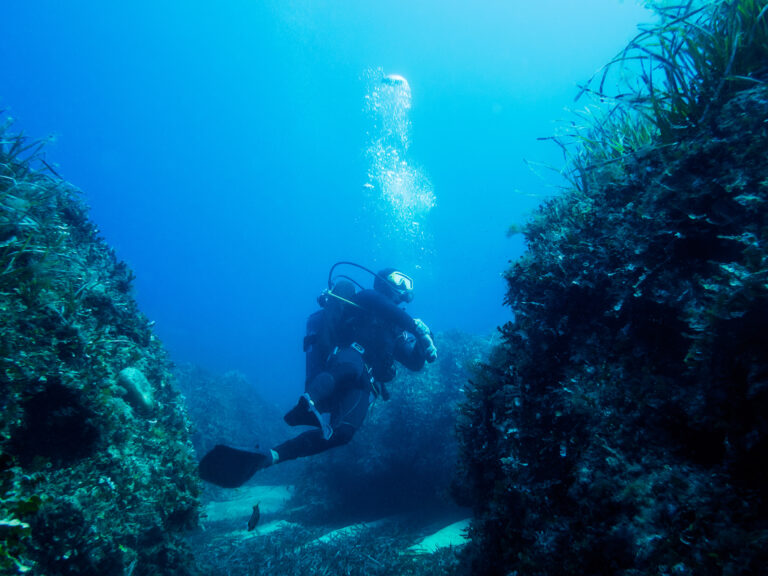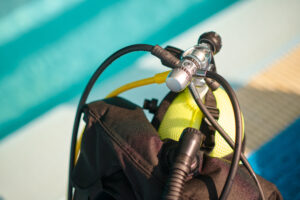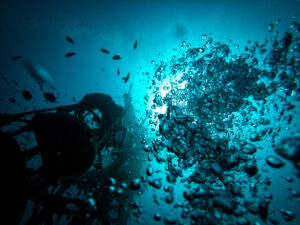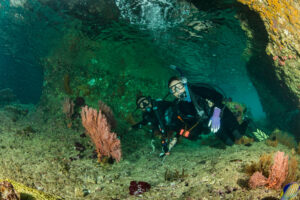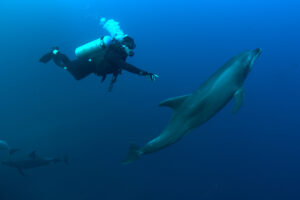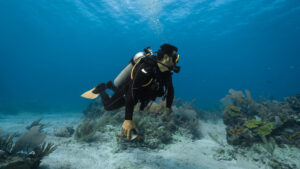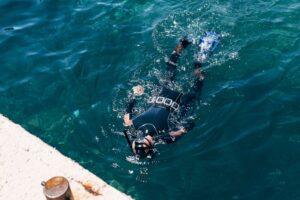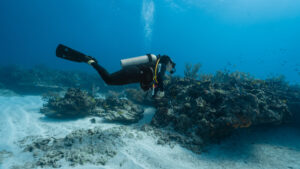What is a Gas Fraction?
In the context of scuba diving, a gas fraction refers to the proportion of each gas component within a breathing gas mixture. Understanding gas fractions is crucial for divers to ensure safe and efficient breathing under water. The significance of gas fractions cannot be overstated, as they directly influence dive planning, physiological effects on the body, and overall safety. By grasping the fundamentals of gas fractions, divers can make informed decisions that enhance their underwater experience while minimizing risks.
Basic Concepts of Gas Fractions in Scuba Diving
A breathing gas mixture is composed of various gases, each contributing to the overall blend that divers inhale. Common gas mixtures include air, nitrox, and trimix. Air, the most basic mixture, consists of approximately 21% oxygen and 79% nitrogen. Nitrox, also known as enriched air, has a higher percentage of oxygen than air, usually between 22% and 40%. Trimix includes helium in addition to oxygen and nitrogen, which helps mitigate the effects of nitrogen narcosis and oxygen toxicity at greater depths.
To understand gas fractions, it is essential to grasp key terms such as partial pressure, total pressure, and volume fraction. Partial pressure refers to the pressure exerted by an individual gas within a mixture, proportional to its fraction of the total pressure. For example, if a gas mixture is at a total pressure of 2 atmospheres and oxygen makes up 50% of the mixture, the partial pressure of oxygen would be 1 atmosphere. Total pressure is the sum of the partial pressures of all gases in the mixture. Volume fraction represents the proportion of each gas by volume within the mixture, typically expressed as a percentage.
These concepts are fundamental for divers to calculate the appropriate gas mixtures for different depths. As depth increases, the total pressure exerted on a diver’s body increases, which in turn affects the partial pressures of the gases being breathed. Therefore, understanding how to adjust gas fractions for specific diving conditions is crucial for maintaining safe and effective respiration underwater.
The Role of Gas Fractions in Dive Planning
Gas fractions play a pivotal role in dive planning, as they are used to calculate safe diving limits and ensure that divers avoid conditions that could lead to decompression sickness or other complications. The selection of an appropriate breathing gas mixture is based on the depth and duration of the dive, as well as the diver’s physiological tolerance to the gas components.
When planning a dive, divers use gas fractions to determine their no-decompression limits—the maximum time they can spend at a given depth without requiring decompression stops during ascent. This involves calculating the partial pressures of oxygen and nitrogen at the planned depth. For instance, diving with air at a depth of 30 meters (98.4 feet) increases the partial pressure of oxygen and nitrogen, which affects the body’s absorption and off-gassing of these gases. By using gas mixtures like nitrox, divers can extend their bottom time and reduce the risk of decompression sickness.
Decompression models also rely on gas fractions to predict safe ascent profiles. These models take into account the absorption and release of inert gases like nitrogen or helium within the body’s tissues. Adjusting gas fractions allows divers to tailor their breathing mixtures to minimize nitrogen uptake and optimize decompression schedules. For example, using a trimix blend with a lower nitrogen fraction and added helium can significantly reduce the risk of nitrogen narcosis and facilitate safer decompression from deep dives.
Calculating the optimal breathing mixture involves several steps. Divers must first determine the maximum operating depth (MOD) for the chosen gas mixture, ensuring that the partial pressure of oxygen remains within safe limits. This is followed by calculating the equivalent air depth (EAD) or equivalent narcotic depth (END) to estimate the narcotic effects of the gas mixture compared to air. These calculations help divers select the most suitable gas mixture for their planned dive profile, enhancing safety and performance underwater.
Gas Fractions and Physiological Effects
The physiological effects of different gas fractions on the human body are a critical consideration for divers. Oxygen toxicity and nitrogen narcosis are two primary concerns associated with the use of various gas mixtures. Understanding these effects and how to manage them is essential for safe diving practices.
Oxygen toxicity occurs when the partial pressure of oxygen exceeds safe levels, leading to harmful physiological reactions. There are two types of oxygen toxicity: central nervous system (CNS) toxicity and pulmonary toxicity. CNS toxicity can cause symptoms such as visual disturbances, nausea, muscle twitching, and convulsions, while pulmonary toxicity primarily affects the lungs, leading to symptoms like coughing and reduced lung function. To mitigate these risks, divers must adhere to recommended limits for oxygen partial pressures, typically not exceeding 1.4 to 1.6 atmospheres for recreational diving.
Nitrogen narcosis, often referred to as “the rapture of the deep,” is a condition caused by the anesthetic effects of nitrogen at high partial pressures. As divers descend, the increased partial pressure of nitrogen can impair cognitive and motor functions, leading to symptoms such as euphoria, impaired judgment, and slowed reaction times. To reduce the risk of nitrogen narcosis, divers may use gas mixtures with lower nitrogen fractions, such as nitrox or trimix, which includes helium to displace some of the nitrogen.
Helium is an inert gas that helps mitigate the effects of nitrogen narcosis and oxygen toxicity. By incorporating helium into the breathing mixture, divers can safely explore greater depths without experiencing the debilitating effects of high nitrogen or oxygen partial pressures. However, the use of helium also requires careful management, as it can lead to high-pressure nervous syndrome (HPNS) at extreme depths. HPNS manifests as tremors, dizziness, and cognitive disturbances, necessitating a balanced approach to gas fraction selection.
The selection of appropriate gas fractions based on dive depth and duration is a dynamic process that requires careful planning and continuous monitoring. By understanding the physiological impacts of different gas fractions, divers can optimize their breathing mixtures to enhance safety and performance.
Gas Management Techniques
Effective gas management techniques are essential for ensuring that divers maintain the correct gas fractions throughout their underwater activities. These techniques involve pre-dive calculations, real-time monitoring, and adherence to safety protocols to handle any unexpected changes in gas consumption or composition.
Before a dive, divers must calculate the appropriate gas fractions based on their planned depth and duration. This involves selecting a gas mixture that meets the desired partial pressure limits for oxygen and nitrogen while considering factors such as the maximum operating depth (MOD) and equivalent air depth (EAD). Divers typically use dive planning software or tables to make these calculations, ensuring that their gas mixture is safe and effective for the planned dive profile.
During the dive, real-time management of gas fractions is crucial to respond to changing conditions. Divers use dive computers equipped with gas monitoring capabilities to track their depth, time, and gas consumption. These devices can provide alerts if gas fractions approach unsafe limits, allowing divers to adjust their breathing mixture or ascent profile accordingly. In addition to dive computers, divers may carry gas analyzers to verify the composition of their gas mixture at any point during the dive.
Safety protocols are vital for handling unexpected changes in gas consumption or composition. For instance, if a diver experiences a rapid increase in gas consumption due to exertion or equipment failure, they must be prepared to adjust their dive plan or switch to an alternative gas supply. Redundant gas supplies, such as pony bottles or stage tanks, provide an additional safety margin, allowing divers to manage their gas fractions effectively even in emergency situations.
Proper training in gas management techniques is essential for divers who use mixed gas systems. This training includes understanding the principles of gas blending, recognizing the signs of gas-related issues, and performing emergency procedures to address gas fraction imbalances. By mastering these techniques, divers can maintain safe and efficient gas fractions throughout their underwater activities.
Technological Aids for Monitoring Gas Fractions
Technological advancements have greatly enhanced the ability of divers to monitor and manage gas fractions effectively. Dive computers, gas analyzers, and advanced sensor technologies play a crucial role in ensuring that divers can accurately track their gas mixtures and make informed decisions underwater.
Dive computers are indispensable tools for modern divers, providing real-time data on depth, time, and gas consumption. These devices are equipped with algorithms that calculate decompression limits and gas fractions based on the diver’s profile. Advanced dive computers can support multiple gas mixtures, allowing divers to switch between different breathing gases during the dive. They also offer visual and audible alarms to alert divers if their gas fractions approach unsafe levels, ensuring timely corrective actions.
Gas analyzers are used to verify the composition of breathing gas mixtures before and during the dive. These devices measure the fractions of oxygen, nitrogen, and helium in the gas blend, ensuring that the mixture matches the planned specifications. By using gas analyzers, divers can confirm the accuracy of their gas mixtures, reducing the risk of breathing an incorrect or unsafe blend. Portable gas analyzers are particularly useful for technical divers who blend their gases on-site, providing a quick and reliable method for gas verification.
Advances in sensor technology have led to the development of continuous monitoring systems that provide real-time data on gas fractions. These systems use sensors integrated into the diver’s equipment to measure the partial pressures of oxygen, nitrogen, and helium. The data is transmitted to a wrist-mounted display or a heads-up display (HUD), allowing divers to continuously monitor their gas fractions without interrupting their activities. This real-time monitoring capability enhances safety by providing immediate feedback on gas composition, enabling prompt adjustments if necessary.
The integration of technological aids into diving practices has significantly improved the accuracy and reliability of gas fraction management. By leveraging these tools, divers can enhance their safety and performance, ensuring that they maintain optimal gas fractions throughout their underwater activities.
Regulatory and Safety Considerations
Regulatory and safety considerations are paramount when handling and utilizing gas fractions in scuba diving. Adherence to established guidelines and standards ensures that divers use gas mixtures safely and effectively, minimizing the risks associated with incorrect gas fractions.
Guidelines for gas blending and fraction calculation are provided by organizations such as the Professional Association of Diving Instructors (PADI), the National Association of Underwater Instructors (NAUI), and the International Association of Nitrox and Technical Divers (IANTD). These organizations offer training programs that teach divers how to blend and manage gas mixtures safely. The training includes theoretical knowledge of gas laws, practical skills in gas blending, and emergency procedures for handling gas-related issues.
Regulatory standards also cover the equipment used for gas blending and analysis. Gas cylinders, regulators, and blending systems must meet specific safety requirements to ensure that they operate correctly and do not introduce contaminants into the gas mixture. Regular maintenance and inspection of this equipment are essential to prevent malfunctions that could affect gas fractions.
Training requirements for handling and utilizing enriched air and other mixed gases are stringent. Divers must complete specialized courses to gain certification in the use of nitrox, trimix, and other gas mixtures. These courses cover topics such as gas physiology, decompression theory, and gas blending techniques. Certified divers are trained to recognize the signs of gas-related issues, perform emergency procedures, and use gas monitoring equipment effectively.
Safety records and statistics highlight the importance of proper gas fraction management. Analysis of diving incidents and accidents often reveals that incorrect gas fractions or improper gas management contributed to the events. By adhering to established guidelines and maintaining rigorous training standards, the diving community can reduce the incidence of gas-related accidents and enhance overall safety.
Regulatory and safety considerations form the foundation of effective gas fraction management in scuba diving. By following these guidelines and standards, divers can ensure that they use gas mixtures safely and responsibly, minimizing the risks associated with underwater activities.
Key Takeaways
Understanding and managing gas fractions is crucial for ensuring safe and efficient scuba diving. By comprehending the principles of gas fractions, planning dives accurately, and utilizing technological aids, divers can optimize their breathing mixtures and enhance their underwater experience. Proper training and adherence to regulatory standards further contribute to safe gas management, reducing the risks associated with diving.

